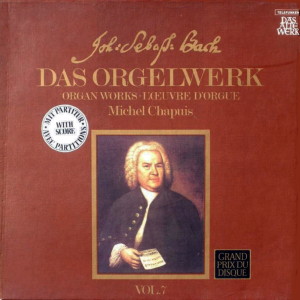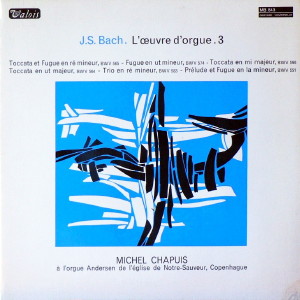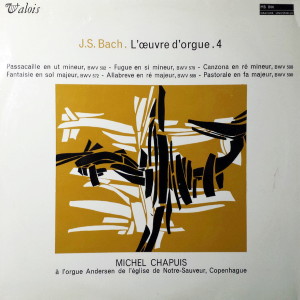 |
|
2 LP's
- BC 25104-T/1-2 - (p) 1967
|

|
| 1 LP -
Valois MB 843 - (p) 1967 |
 |
| 1 LP -
Valois MB 844 - (p) 1967 |
|
| DAS ORGELWERK -
VOL. 7 |
|
|
|
|
|
| Johann
Sebastian Bach (1685-1750) |
|
|
|
|
|
| Long Playing
1 - (Valois MB 843) |
|
|
| Toccata (Toccata
und Fuge) d-moll, BWV 565 |
7' 50" |
|
| Fuge c-moll über
ein Thema von Giovanni Legrenzi,
BWV 574 |
6' 10" |
|
| Toccata
E-dur, BWV 566 (Präludium
und Fuge) |
9' 15" |
|
|
|
|
| Toccata
(Toccata, Adagio und Fuge) C-dur,
BWV 564 |
13' 03" |
|
| Trio
d-moll, BWV 583 |
4' 05" |
|
| Präludium
und Fuge a-moll, BWV 551 |
5' 08" |
|
Long Playing
2 - (Valois MB 844)
|
|
|
| Passacaglia
c-moll, BWV 582 |
12' 28" |
|
| Fuge
h-moll über ein Thema von Corelli,
BWV 579 |
3' 51" |
|
| Canzona
d-moll, BWV 588 |
5' 03" |
|
|
|
|
| Fantasie
G-dur, BWV 572 |
8' 16" |
|
| Allabreve
D-dur, BWV 589 |
3' 12" |
|
| Pastorale
F-dur, BWV 590 |
11' 21" |
|
|
|
|
| Michel Chapuis |
|
an
der Andersen-Orgel der
Erlöser-Kirche, Kopenhagen
|
|
|
|
|
|
Luogo
e data di registrazione |
|
Kopenhagen
(Danimarca) - febbraio 1967 |
|
|
Registrazione: live /
studio |
|
studio |
|
|
Producer / Engineer |
|
Michael
Bernstein |
|
|
Prima Edizione LP |
|
- Valois
- MB 843 · Vol. 3 - (1 LP) -
durata 46' 13" - (p) 1967 -
Analogico
- Valois - MB 844 · Vol. 4 - (1
LP) - durata 40' 23" - (p) 1967 -
Analogico
|
|
|
"Das Orgelwerke" LP |
|
Telefunken
- BC 25104-T/1-2 - (2 LP's) -
durata 46' 13" / 40' 23" - (p)
1967 - Analogico |
|
|
Note |
|
- |
|
|
|
|
|
Bach’s mode of
composition displays from
the outset a tendency
towards the great and the
diverse. Despite the
narrowness and provinciality
of the conditions under
which he had to work, his
artistry is cosmopolitan in
outlook. Any attempt to
adapt himself to his musical
environment or to restrict
himself to simplicity and
modesty was alien to him.
This also accords with the
inclination to try out the
various genres, forms and
styles from the most varied
aspects in a systematic
manner, never forgoing any
impetus but always searching
for his own more appropriate
solution. In this respect
there is the combination of
a thirst for knowledge,
pride in craftsmanship and
speculative talent, as well
as the delight - already
evident in his youth - in
seeing compositional tasks
as parallel exercises of the
intellect.
The early piano and organ
works provide especially
abundant illustrative
material of the wealth of
forms in which he
experimented, which he
further developed or which,
after trying out,
disregarded altogether. The
present album contains
compositions of the most
diverse kinds, giving
wide-ranging examples of the
strictly imitative and the
toccata-like prelude styles
of movement and their
connection with the
complete, multipart work. In
addition there is the
ostinato form of the
passacaglia, the aria form
of the trio and the
sonata-style movement
sequence of the pastoral.
The formal and stylistic
diversity is already
expressed in the various
titles of the works. In some
cases they are genre titles
which at the same time
indicate style and formal
arrangement (toccata,
prelude, fugue, canzona,
passacaglia, fantasia). In
other instances they give
(as in “trio”) only the type
of movement and sometimes
the stylistic tradition
(alla breve) or also the
designation and melodic type
(pastoral). Except for the
Trio and the Pastoral, and
perhaps also the G major
Fantasia, they are youthful
works or compositions from
the nascent mastery of the
early Weimar years. It is at
first difficult to accept
the fact that even the
famous D minor Toccata and
the grand Passacaglia are
also part of these early
works. However, the sources
from which these pieces have
been handed down, clearly
indicate this period. The
early works fascinate us
because of the impetuous
power of their themes, the
bold flourishes, the manner
which often extends to sheer
high spirits, with which the
virtuoso performer was able
to display his brilliance by
way of his instrument. As
yet the thoughtful
contrapuntal combination,
the polyphonic independence
of the parts, the harmonic
richness are missing, and
the art of letting the
musical form grow of itself
from the possibilities of
the theme is only slowly
developed. The form is still
more impelled by powerful
flourishes than built up on
the foundations of inner
musical media. Thus the
problem of the musical
cohesion in the early works
is resolved for the first
time where such cohesion is
already laid down by the
compositional genre: in the
chorale arrangements and the
themes above an ostinato
repeated bass, as here in
the C minor Passacaglia.
Toccata and Fugue D
minor, BWV 565
The old toccata form with
its frequent alternation of
figurative and fuguing
sections is reduced here to
a clear three-part style: a
broadly structured fugue is
encompassed in figurative
sections. The introductory
first section is almost
incomparable in its
compelling temperament. It
has the effect of an orator
who, with his very first
words, intends to hold the
audience in his spell. Rapid
scalar passages with fermata
conclusion, ascending and
descending figures leading
to fully stopped blocks of
chords, alternating play of
the hands, the emphatic
application of the pedal:
these trusted and tried
elements of the free toccata
theme are welded into an
irresistible prelude which
exploits in a concise way
the tension of the dominant
harmony. The toccata spirit
also lives in the marked
homophonically arranged
fugue with its long
interludes and its thematic
announcement at the
beginning of the
introductory passage. The
final part reverts to the
figurative and chordal
themes of the beginning and
intensifies them.
Fugue in C minor on a
Theme by Legrenzi, BWV 574
Even before he had become
acquainted with the Italian
solo concerto, Bach had
studied the trio sonatas of
the great Italian violinists
and learned from their
song-like instrumental
style. His fugues on themes
by Corelli, Albinoni and
Legrenzi testify to this
fruitful preoccupation. He
recognized at once how he
could profit from the
plastic themes of the fugued
allegro movements for his
own art and, going beyond
the examples, showed how the
possibility inherent in the
themes could be presented in
a complete movement. He
changed the al fresco of the
Italians into well
constructed architecture. In
the present work, the
original pattern of which
has evidently been lost, he
formed from the adopted main
theme and a second one,
which from the beginning was
probably initially
counterpointed in the
original, a three-part
double fugue which runs into
a figurative coda. Both
themes are exposed in turn
and only brought together in
the third part. Two earlier
versions (BWV 574a and b) -
the first still without the
coda - show how seriously
Bach devoted himself to the
work on this fugue.
Prelude (Toccata) and
Fugue E major, BWV 566
The first fugue follows a
prelude which begins
figuratively and concludes
with a tightly textured
section. It is based on an
unusually long, almost
clumsy theme which, however,
in the contrapuntal
arrangement immediately
loses its awkward shape and
proves to be particularly
productive. The second
fugue, which follows after a
brief connecting passage,
forms the beginning of this
theme in three-part metre
and in the transition leads
from contemplative calm to
concerto-like thrilling
mobility into the homophonic
coda. Thus in this work the
toccata-style construction
merges with the variation
principle of the canzona.
Toccata C major, BWV 564
In this work the tendency to
adapt in the toccata the
original free alternation of
figurative and fugued
sections into a sequence of
intrinsically complete
movements reaches a climax.
The second movement, which
thematically emerges from
the introductory figuration,
resembles a concerto allegro
constructed on the contrast
between an ascending scalar
figure and a descending
triad motif. The third
movement is a copy of a solo
concerto adagio. Accordingly
the framework, the
figurative prelude and
particularly the concluding
fugue, is extended.
Subsequently Bach did not
further develop this
multi-theme arrangement. The
coupled movement prelude
(toccata) and fugue provided
greater possibilities for
his mode of composition
which oriented towards
concentration.
The Trio in D minor, BWV
583, belongs as
regards style and period to
the great trio sonatas of
the 1720’s
(see Organ Works, I) and
could be the centre movement
in one of these works
constructed in concerto
style. With the
non-schematic manner in
which the various imitation
sections are developed from
each other, repeated and in
the centre part augmented by
an eloquent counter motif,
it virtually amounts to a
model of a free da capo
form.
As regards the Prelude
and Fugue A minor, BWV
551, this is in shape
more of a five-part
toccata: two fugues, in
second and fourth place, are
framed and combined with
toccata-like sections. The
first fugal theme is
developed from the
semi-quaver movement of the
introductory part; the
second is linked, by way of
the firm counterpoint which
it immediately takes on,
with the first. The short
piece is one of Bach’s
earliest compositions to
have come down to us.
Although in many respects
incomplete, it nevertheless
makes a powerful impression
and provides a first notion
of the master who was to
come.
Passacaglia C minor, BWV
582
Passacaglia and
chaconne, series of
variations deriving from the
dance, in slow three-four
time above an unchanging
ostinato repeated bass
theme, were at their height
in the instrumental music of
the outgoing 17th century.
When Bach became involved in
them they were already out
of fashion. However, it is
doubtful if this is the
reason why he did not go
beyond this one organ
passacaglia and the sole
violin chaconne. It is
perhaps more likely that he
had also completely
exhausted the possibilities
of this form in the two
contrary and incomparably
magnificent works. Instead
of the usual four bar, Bach
uses in the organ
passacaglia an eight-bar
theme which he achieves by
extending a four-bar
passacaglia bass by André
Raison. In 21 periods of
eight bars each he builds up
the work above the
unchanging theme and lets it
fade away in only a slightly
shorter fugue on this theme.
His mastery is particularly
evident in the interlacing
of the individual periods,
their combination into
larger units, in the art of
not letting the flow break
off but continuing it in a
compelling and tension-laden
manner. The principle of the
rhythmic-figurative
variation progressing from
period to period is
subordinated to the law of
greater cohesion, as already
apparent for instance in the
melodic summary of the 2nd
and 3rd period, or even more
clearly in the 12th period.
Precisely where the theme is
transferred from the pedal
bass to the discant, the
figuration modus of the
preceding section is
maintained. This following
on process creates the
precondition for the broadly
conceived final augmentation
which begins with the 17th
period, just where the theme
- descending by way of alto,
tenor and manual bass - has
once more returned to the
pedal. The crowning final
fugue uses only the four-bar
main subject, which proceeds
in alternating crotchets and
minims, and links it up with
a countersubject in quaver
movement and a second in
semi-quavers.
Fugue in B minor on a
Theme by Corelli, BWV 579
The basis is a 39-bar
long fugato from the Trio
Sonata op. III, No. 4 by
Corelli published in 1689.
The theme and counter-theme
are set out there, and the
possibility of stretto is
also already utilized. In
Bach’s hands this “material”
exposed for three parts
changes into a four-part
fugue extending to 102 bars
with several expositions and
long episodes. The larger
scale arrangement cannot,
however, disguise the fact
that when transferred to the
organ the character of the
themes has also changed.
Their electrifying verve
comes more into its own in
the al fresco of the violin
fugato than in the carefully
balanced architecture of the
fugue.
Canzona in D minor, BWV
588
The canzona, an instrumental
imitation of the French
chanson with its series of
imitative and homophonic
sections, effected as early
as 1600 the transition to
the fugue, namely with
restriction to a single
theme that was varied in
several sections. What
finally remained was
development of the theme
into an even bar and an
uneven bar section. This two
part form is also strictly
adhered to by Bach’s sole
work described in the title
as a “Canzona”, one of the
most mature testimonies from
Bach’s early period. The
confidently progressing long
theme is counterpointed with
the well-known chromatic
descending fourth.
Fantasia in G major, BWV
572
This work, unusual as
regards both construction
and content and described in
only very general terms by
the title “Fantasia”,
appears to be based on
French patterns. This is
also indicated by the French
movement descriptions. Two
figured movements, headed
“Très
vitement” and “Lentement”,
provide the framework for an
extended five-part
“Gravement” which in its
density (while renouncing
imitation) and persistent
intensity based upon
suspended harmony (waiving
formal cuts or rhythmic
alternation) has
scarcely anything to compare
with it. However,
the“fantastic” urgency,
apparently directed towards
boundlessness, acquires a
firm hold by way of strict
control of the individual
parts and the bass
foundation which continually
binds the harmonic sequence
to a gradual, upward moving
tonal progression.
The Allabreve in D major,
BWV 589, is, as far as
the theme and manner of the
exposition are concerned,
related to the D minor
Canzona, except that the
exacting length is not
achieved by the change in
movement form, but by the
normal fugal construction
with long episodes. A major
contribution to the
overlapping cohesion is
provided by a quarter
movement no longer
interrupted as from the 6th
bar which is gained from the
4th bar of the theme. The
title “allabreve” indicates
the stylistic descent from
the ricercar with its
motet-like construction,
which avoids concerto-style
elements and - reverting to
the old vocal polyphony - is
scored in large note values
which have to be read “alla
breve”.
Pastorale in F major, BWV
590
Oboe melody above bourdon
notes, since the 16th
century the musical image of
the shepherd’s idyll, are
bound up in the church
pastoral with the rocking
rhythm of 6/8 or
12/8
beats; for this now refers
to the Christmas world of
the shepherds at the manger.
Bach’s organ pastoral was
most certainly composed for
the Christmas church
service. The main movement,
which builds up above long
sustained bourdon tones of
the pedal, is joined by
three manual movements, of
which the second, the slow
one, is in the minor key of
the upper fifth (C minor),
unusual in such sonata-style
sequences.
by Georg
von Dadelsen
English
translation by
Frederick A. Bishop
This critical
and complete stylistic
survey of Bach's
organ works is
the seventh
part and
will be
continued by
further
releases.
|
|
|
Johann
Sebastian Bach - DAS
ORGELWERK
|
|
|
|

